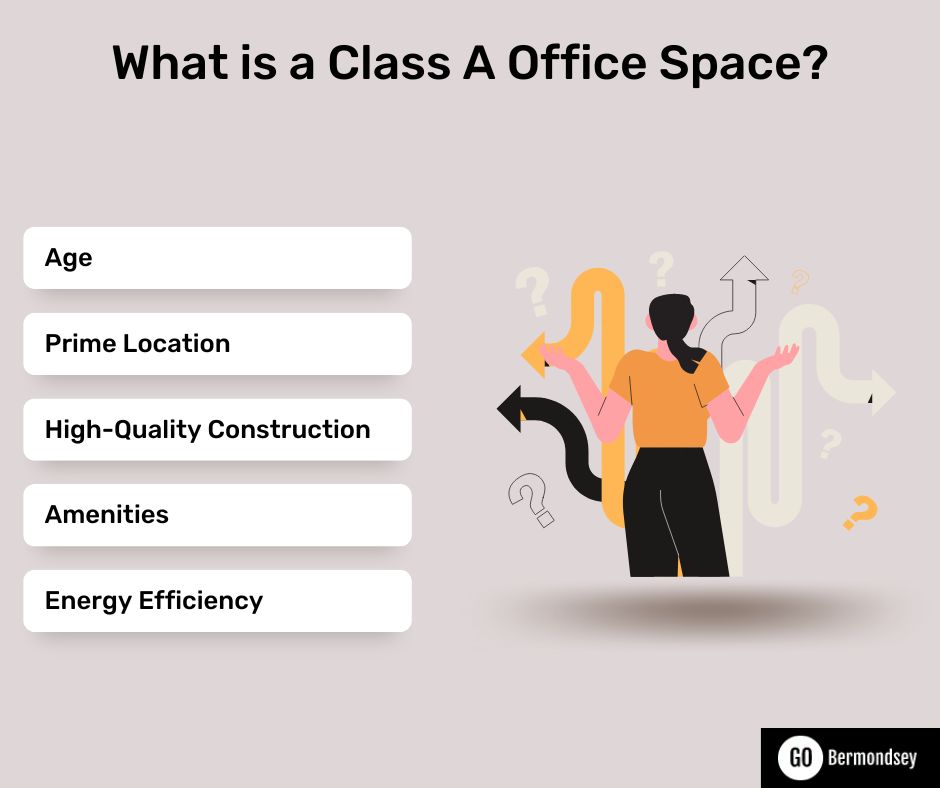Where you work from can define your company culture, productivity, and even your brand image. The perfect space for your business is one that aligns with your specific needs and aspirations. But with so many options available, how do you find the right commercial office space for rent?
A good starting point in your search would be understanding the nuances of Class A, B, and C office space classifications. These classifications, based on factors like the age of the building, amenities offered, and location, significantly impact cost, employee experience, and brand image. In this article, we discuss office building classification, how it’s done and take a closer look at the distinction between Class A, Class B, and Class C offices.
Garden Office Bermondsey offers a range of flexible, high-quality workspaces designed to elevate your business. Located in a vibrant district of London, our offices provide the perfect blend of functionality, style, and convenience.
Explore premium office space options in London, including Garden Office Bermondsey. Check availability now!
What is Office Building Classification?
Office building classification refers to the system or criteria used to categorise office space. It helps real estate professionals, investors, and tenants to better understand the relative quality and value of different office properties within a given market.
But how are these grades determined? For fair gradation, buildings undergo a thorough evaluation based on factors such as construction quality, infrastructure, technological features, building age, and location.
Newly built or renovated offices in prime locations with superior amenities and transportation are typically classified as Class A spaces. Additionally, elements like building appearance, maintenance standards, and available amenities also influence the grading process.
BOMA also notes that office building classifications vary depending on the specific market they are situated in. For instance, a Class B office space in London might be categorised as a Class A office space in Camden.
What is a Class A Office Space?
Class A offices represent the cream of the crop in commercial real estate. They are constructed using top-notch materials and techniques. Managed by professionals, they offer excellent accessibility and often occupy prominent locations on busy streets. Due to their superior quality, amenities, and desirable locations, Class A offices generally command the highest rental rates.

Here’s a breakdown of their key features and criteria:
- Age: Class A offices are typically located in newly constructed buildings. However, some are situated within renovated buildings that have been upgraded to meet modern standards and specifications.
- Prime location: Class A buildings are typically situated in the most prestigious areas of a city or town, often in the central business district or a major suburban office hub. These locations offer easy access to transportation, restaurants, and other amenities.
- High-quality construction: Class A office buildings are constructed with superior materials, modern architecture, and advanced building systems. They often feature high ceilings, large windows, and impressive lobbies.
- Amenities: They offer a variety of amenities, including fully equipped meeting and conference rooms, restaurants, and breakout facilities. Class A offices also provide professional services such as security staff, parking facilities, and clerical and administrative support.
- Energy efficiency: Many Class A buildings incorporate energy-efficient features, such as LEED certification or other green building standards, to reduce operating costs and environmental impact.
Private Offices to Rent in Bermondsey
Which Businesses Should Opt for Class A Office Space?
Businesses that choose Class A offices typically prioritise making a lasting impression on employees and clients. Often situated in financial districts, these businesses include law firms, architecture firms, advertising agencies, and financial management companies.
What is a Class B Office Space?
Class B offices refer to commercial properties that are a step below Class A in terms of quality, age, and amenities. These buildings are generally slightly older but still offer good management and reputable tenants. Class B office spaces are often targeted by investors who plan to renovate them to improve their condition. These buildings typically have the following characteristics:

- Location: Class B buildings are located in decent areas, though not necessarily in the prime central business districts or most prestigious suburban office hubs.
- Age: Many Class B office properties are slightly older buildings, often constructed several decades ago, but they are well-maintained and receive periodic updates and renovations.
- Building quality: Class B office buildings feature fair to good-quality finishes, such as an acceptable curtain wall facade and decent interior build-outs. The overall space is still quite functional, although not at the same level as that of Class A buildings.
- Systems: The mechanical, electrical, safety, and security systems in Class B properties are in good working condition.
- Rental rates: Class B office spaces are generally more affordable than Class A properties in the same market.
Which Businesses Should Opt for Class B Office Space?
Businesses seeking cost-effective office solutions without sacrificing functionality can benefit from Class B office spaces. This category is well-suited for small to medium-sized enterprises (SMEs), IT firms, call centres, creative startups, and branch offices. Class B spaces offer a balance between affordability and practicality, making them suitable for businesses looking to minimise expenses while still meeting their operational needs.
What is a Class C Office Space?
Class C office spaces refer to the lowest tier of office buildings in terms of quality, amenities, and location. These buildings typically have older infrastructure and basic maintenance and may lack modern amenities such as updated technology, or stylish interiors.
Class C offices are often found in older areas of the city, have lower rental rates than Class A and B spaces, and may require significant renovations or upgrades to meet the needs of modern businesses. Key characteristics include:
- Older buildings in older sections of the city.
- High vacancy rates.
- Outdated architecture and infrastructure.
- Need extensive renovations.
- Obsolete technology.
- Lower rental rates but challenging to lease.
Which Businesses Should Opt for Class C Office Space?
Class C office spaces are usually well-suited to those seeking affordable options or willing to trade off prestige and amenities for lower costs. They are especially attractive to startups, small businesses, and non-profit organisations with tight budgets. Additionally, these spaces are suitable for companies with administrative functions, limited face-to-face client interactions, or those in need of light industrial or storage areas.
Which Type of Office Building Classes Should You Choose?
The choice between office classes A, B, and C depends on your requirements and preferences, as each class offers unique amenities tailored to different commercial needs. Here are some considerations to help you make an informed decision:
- Budget
This is one of the most critical factors in deciding which class of office space to choose. Class A spaces offer premium quality and locations but come with higher rent. If your budget allows, investing in a Class A office can enhance the prestige and attract top talent. However, if you need to allocate resources conservatively, Class B or Class C spaces might be more suitable.
- Specific space and needs
Evaluate what amenities and features are essential for your business operations. Class A office spaces might be the best fit if you require advanced technological infrastructure, on-site management, and a prime location to impress clients.
On the other hand, if you require only basic amenities without incurring significant costs, Class B would be a better option. Conversely, Class C office space might suit those businesses that have minimal facility requirements, such as those that primarily require storage areas.
- Location
Location can significantly impact your business’s visibility and accessibility. Class A buildings are located in prime areas that are easily accessible and near major business hubs like Westminster, the City, or Waterloo. Class B offices, a good alternative to Class A offices, are often located in accessible areas without the premium cost. Class C buildings, while less central, can be viable for businesses that do not rely on a prime location.
- Company image
If projecting a prestigious corporate image is essential for your business, then Class A is the best choice with its impressive lobby, superior finishes, and prime address. While Class B can also offer a professional environment, Class C offices may not be suitable for businesses aiming for an upscale image.
In addition to these factors, consider flexibility, lease agreements, technological infrastructure, and sustainability features. Taking these elements into account ensures that your choice aligns with your business’s current and future needs.
Difference between Class A vs Class B vs Class C office space
The table below represents the key differences between the Class A, Class B and Class C office space.
| Characteristic |
Class A |
Class B |
Class C |
| Cost |
Highest |
Moderate |
Lowest |
| Building Age |
New or recently renovated |
Older, may need renovations |
Oldest, often requires significant repairs. |
| Location |
Prime locations, central business districts |
Suburban areas, secondary locations |
Less convenient or ordinary areas |
| Amenities |
Top-tier amenities: gyms, cafeterias, parking |
Fewer amenities than Class A, but still has basic services |
Minimal or no amenities |
| Technology |
Advanced building systems (HVAC, elevators, and security) |
Standard technology; may need upgrades |
Outdated technology, significant upgrades needed |
| Maintenance and Management |
Professional, high-standard maintenance and management |
Adequate maintenance and management |
Basic or poor maintenance and management |
Commercial office spaces for rent: Why do they matter?
Commercial office spaces for rent are hubs for collaboration, innovation, and productivity, which means they facilitate efficient business operations. A well-designed commercial building office provides a professional environment that fosters employee engagement and strengthens brand identity. These spaces are strategic assets that contribute to a company’s overall success.
Garden Ofiice Bermondsey recognises the importance of providing businesses with optimal work environments. Our commercial office space for rent offers a range of flexible and inspiring solutions, designed to meet the evolving needs of modern businesses. With a focus on quality, convenience, and community, Garden Office Bermondsey empowers businesses to thrive in a dynamic market.
Why Choose Garden Office Bermondsey?
Bermondsey is quickly becoming a prime location for businesses in London, and Garden Office Bermondsey stands out as a premier workplace solution. Our offices are strategically situated near London Bridge and are just a 15-minute tube ride from key areas like Westminster, The City, and Waterloo. With its proximity to Canary Wharf, a global financial center, Garden Office Bermondsey makes an excellent choice for startups and entrepreneurs. Garden Office Bermondsey caters to the diverse needs of modern businesses. Our workspaces are meticulously designed and fully equipped with state-of-the-art amenities. These include advanced video conferencing technology, high-speed internet, printing facilities, ergonomic furniture, professional office assistance, and secure parking. What’s more, our flexible leasing options allow you to rent workspaces for any duration, whether just a few hours, a couple of days, or longer. This will enable you to scale up or down without the constraints of traditional long-term leases. Contact – Garden Office Bermondsey today!
Conclusion
Class A, B and C Office Spaces: Choosing the right one
Office spaces are typically classified as Class A, B, or C, reflecting their quality, amenities, and location.Class A represents premium commercial office space for rent with modern infrastructure and prime locations, while Class C spaces are more functional and budget-friendly. Choosing the right class means you are selecting an office space that aligns with your business needs, budget, and brand image. It helps you achieve optimal productivity levels and create an engaging work environment that attracts top talent.







